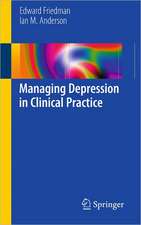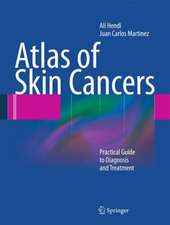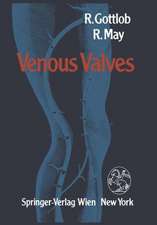Neurology: Management of Common Diseases in Family Practice
Autor T. Fowler, R. Mayen Limba Engleză Paperback – 23 aug 2014
Preț: 365.25 lei
Preț vechi: 384.48 lei
-5% Nou
Puncte Express: 548
Preț estimativ în valută:
69.89€ • 73.16$ • 58.17£
69.89€ • 73.16$ • 58.17£
Carte tipărită la comandă
Livrare economică 31 martie-14 aprilie
Preluare comenzi: 021 569.72.76
Specificații
ISBN-13: 9789401095464
ISBN-10: 9401095469
Pagini: 232
Ilustrații: X, 218 p.
Dimensiuni: 155 x 235 x 12 mm
Greutate: 0.33 kg
Ediția:Softcover reprint of the original 1st ed. 1985
Editura: SPRINGER NETHERLANDS
Colecția Springer
Seria Management of Common Diseases in Family Practice
Locul publicării:Dordrecht, Netherlands
ISBN-10: 9401095469
Pagini: 232
Ilustrații: X, 218 p.
Dimensiuni: 155 x 235 x 12 mm
Greutate: 0.33 kg
Ediția:Softcover reprint of the original 1st ed. 1985
Editura: SPRINGER NETHERLANDS
Colecția Springer
Seria Management of Common Diseases in Family Practice
Locul publicării:Dordrecht, Netherlands
Public țintă
ResearchCuprins
1. Introduction.- The history: the GPs role: drugs prescribed, allergies A brief neurological examination: special aspects vision, pupils, nystagmus.- Specialised neurological investigations in hospital. Indications for hospital admission.- 2. Headache.- History. Recurrent headaches—migraine, management. Acute headache — infective, haemorrhagic, raised intracranial pressure, arteritis.- Chronic headache, depression, tension. Subdural haematoma. Others.- 3. Loss of Consciousness.- Vascular: syncope — cough, micturition, carotid sinus.- Cardiac causes.- Migraine. Transient global amnesia. Epilepsy. Types of fit, major, petit mal. Partial seizures.- Causes, investigations. Treatment. Driving. Employment. Duration of treatment.- Status epilepticus. Febrile convulsions. Childhood seizures.- Rare causes — breath-holding, narcolepsy, metabolic. Non-epileptic seizures (hysterical).- 4. Giddiness.- Nystagmus. Acute vestibular and labyrinthine failure.- Positional vertigo. Ménière’s disease. Central vertigo — multiple sclerosis, vascular disease.- Chronic ataxia — cerebellar signs, cerebellopontine angle tumours.- Progressive unsteadiness.- 5. Facial Pain.- Acute — dental, sinusitis, ocular, trauma. Recurrent — migrainous neuralgia and migrainous variants. Trigeminal neuralgia.- Chronic — compressive causes, post-herpetic neuralgia, temporo-mandibular joint dysfunction, atypical facial pain.- Bell’s palsy.- 6. Visual Disturbances.- Acute visual failure — optic neuritis, ischaemic papillitis.- Transient visual loss. Compression — optic nerve and chiasm.- Retro-chiasmal pathways. Chronic visual loss — ocular, compressive, toxic, inherited.- Double vision. Assessment. Ocular motor palsies.- Dysthyroid eye disease. Myasthenia gravis. Conjugate gazeproblems, internuclear ophthalmoplegia, supranuclear palsies. Ocular myopathies.- Proptosis with ophthalmoplegia.- 7. Failing Memory.- Assessment. Dysphasia. Parietal and frontal lesions.- Brain failure: causes — senile and Alzheimer’s dementia, multi-infarct dementia, normal pressure hydrocephalus.- Search for causes; investigations; management.- 8. Cerebrovascular Disease.- Strokes — pathogenesis, outcome, presentation. Subarachnoid haemorrhage. Treatment-home or hospital? Psychological upsets.- Transient ischaemic attacks — management. Stroke risk factors, prevention.- 9. Back and Limb Pain, Weakness.- Back pain.- Painful weak arm — Cervical disc, spondylosis. Brachial plexus.- Peripheral nerve — carpal tunnel, ulnar nerve lesion.- Painful weak leg — disc prolapse. Foot drop. Sphincter upsets.- Diabetic amyotrophy. Meralgia paraesthetica. Lateral popliteal palsy.- General weakness — polyneuropathy, acute (Guil-lain-Barré). Chronic-diabetic, heredofamilial, others. Muscle disorders — dystrophies, polymyositis, polymyalgia rheumatica.- Myasthenia gravis.- 10. Gait Disorders.- Causes.- Children — spastic and flaccid weakness, clumsy and unsteady.- Adults — spastic and flaccid weakness. Spinal cord infarction.- Syringomyelia. Sub-acute combined degeneration.- Motor neurone disease.- Spinal cord compression. Falls in the elderly.- 11. Involuntary Movements.- Tremor, tics, chorea, dystonia. Spasmodic torticollis, writer’s cramp, oro-mandibular dystonia. Hemifacial spasm. Restless legs.- 12. Multiple Sclerosis.- Presentation. In new patients, investigations, treatment. When to tell. The chronic patient — sphincter problems, spasticity, skin care, aids, questions.- 13. Parkinson’s Disease.- Presentation. Prognosis. Treatment. Problems andfailure of treatment.- 14. The Unconscious Patient, Head Injuries.- Assessment, immediate measures. Causes. Management.- Head injuries: assessment, when to admit? Extradural haematoma.- Residual sequelae. Post-traumatic epilepsy. Post-concussive states.- 15. Spinal Cord Injuries.- Incidence. First aid management and transport. Long term sequelae, rehabilitation. Resources available. Aids at home.- References.- Proprietary Drug Names.
















